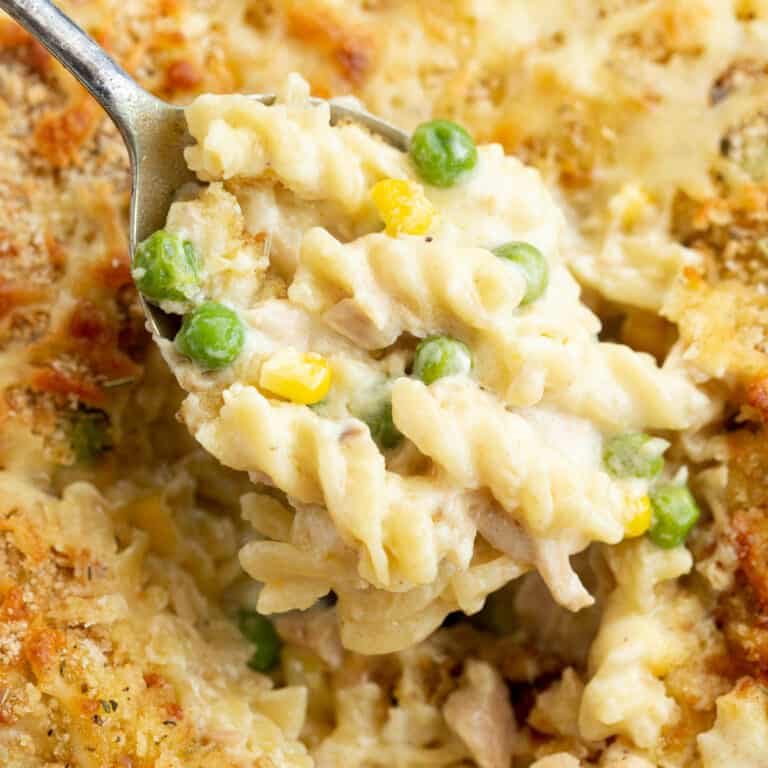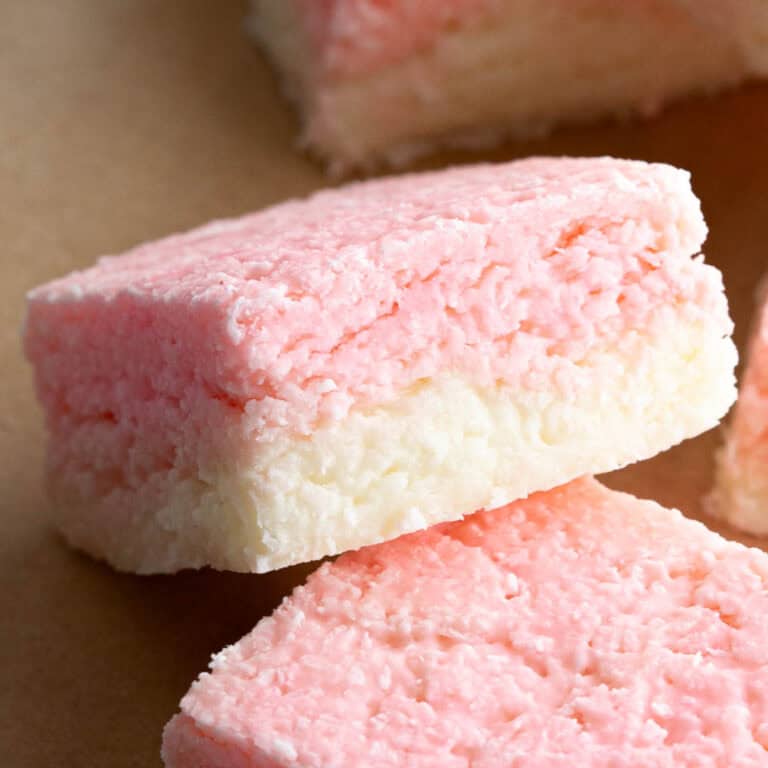How to Cook Sushi Rice – Rice Cooker, Instant Pot & Stovetop
Cooking the perfect sushi rice at home has never been easier! Learn how to cook sushi rice using three easy methods – rice cooker, instant pot or stovetop. No soaking required and only 5 minutes prep.

In This Post You’ll Learn
Why We Love This
Making sushi rice at home is one of the most satisfying and helpful kitchen skills to have. Master this, and you’ll be able to whip up classic hand roll sushi, onigiri or sushi bowls in no time.
We’ve got you covered no matter what equipment you have on hand. Rice cooker? Check. Instant pot? You bet! Classic stove top? Yep. Get ready for fluffy, sticky, PERFECT sushi rice.
Related: Miso Soup / Teriyaki Tofu / Kinpira Gobo

What is Sushi Rice?
Japanese sushi rice is a premium short grain rice, shorter and rounder than it’s basmati and jasmine counterparts. It’s also a sticky rice, making it the perfect medium to form those small bite-size sushi pieces. While Japan is known as the sushi capital of the world, sushi rice or short grain rice actually originates from China!
What You’ll Need
- Sushi Rice – The most popular type of sushi rice is koshihikari, and this is the type we recommend. It’s now found in most supermarkets, Asian grocers or online. The short grain rice is small, and will be noticeably different from long grain rice. While there is no true substitute for sushi rice, the closest would be to use arborio rice.
- Water – Where possible, use filtered cold water for the tastiest finish!
- Sushi Vinegar – Also known as seasoned rice vinegar, this sweet and salty vinegar infuses with the rice and complements the flavours of fish when used in sushi. As a bonus, it also adds to the stickiness and helps the rice to hold its shape. You can easily make it at home with a ratio of 3:2:1 (3 tsp rice wine vinegar (or apple cider vinegar), 2 tsp sugar and 1 tsp of salt). Lightly heat on the stove or in the microwave until the sugar and salt have dissolved. Or use store bought sushi vinegar – the most popular brand is Nakano. Look for the red cap – this is pre-seasoned with sugar and salt. The green cap is just regular rice wine vinegar.

How to Cook Sushi Rice at Home:
In a Rice Cooker


- Place sushi rice into the rice cooker bowl, cover with water and rinse 2-3 times using your hands until water is more translucent (doesn’t have to be clear). Drain.
- Fill water to the 2 cup fill line in your rice cooker.
- Select Rice and Start. (Or the applicable buttons for your model. Button names may vary depending on your rice cooker.)
In an Instant Pot (Pressure Cooker)
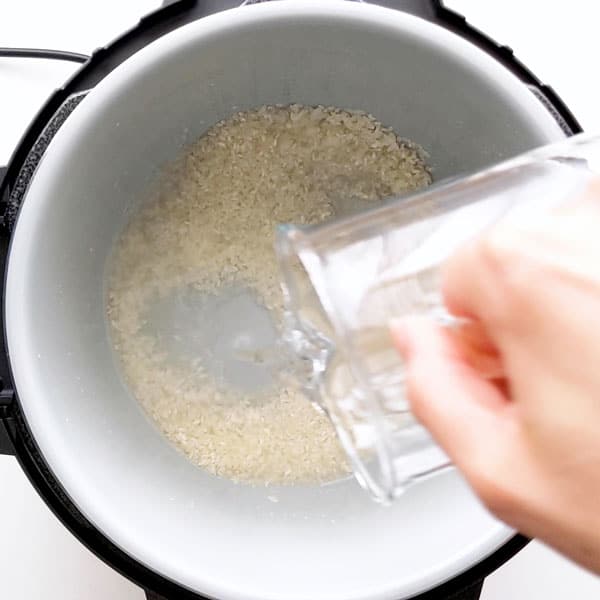

- Place sushi rice into the instant pot bowl, cover with water and rinse 2-3 times using your hands until water is more translucent (doesn’t have to be clear). Drain. Add the 1 cup of water to the rinsed sushi rice. Place pressure cooker lid on and make sure it is sealed correctly and the valve is closed.
- Cook on High Pressure – 3 minutes, then natural release steam for 10 minutes. Slow release any remaining pressure.
On the Stove (No Soaking Required)
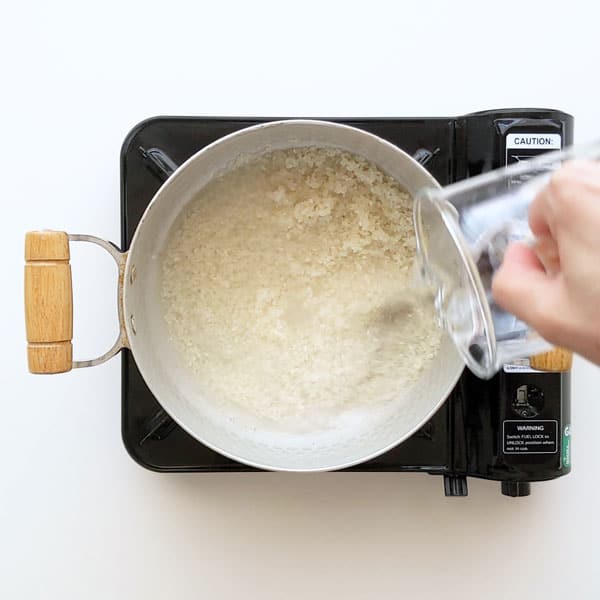

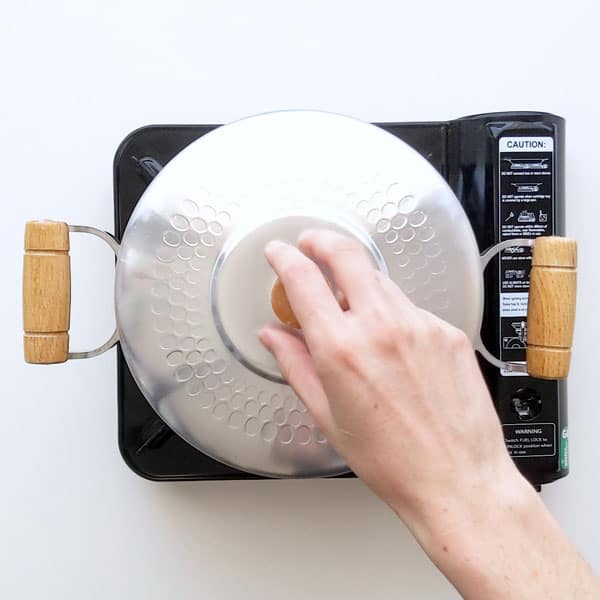
- Add sushi rice to a medium saucepan, cover with water and rinse 2-3 times using your hands until water is more translucent (doesn’t have to be clear). Drain.
- Add the 1 ¼ cups of water to the rinsed sushi rice. Place over high heat and bring to a boil with the lid off.
- Next, cover and reduce to the lowest setting for 15 minutes. Take off heat and steam for further 10 minutes with the lid still on. Note: Do NOT remove the lid to peek at all during the cooking process, the steaming is crucial to perfect rice.
- Finally, remove the lid.
How to Season Sushi Rice with Vinegar
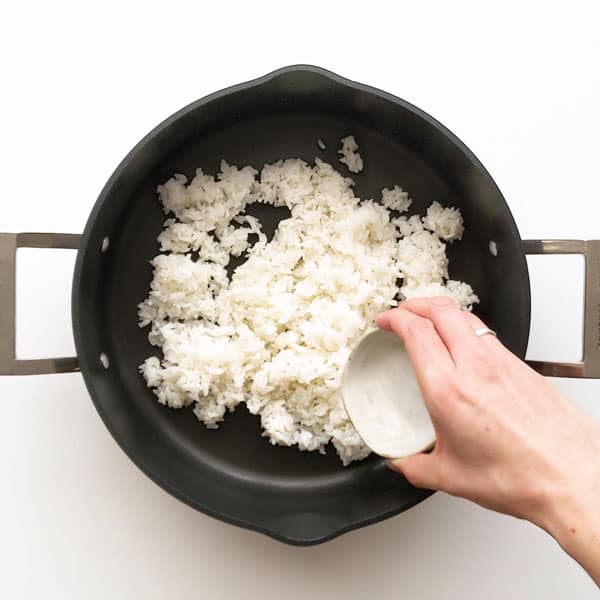

- Allow sushi rice to cool by transferring into a wooden bowl, non-stick wide pan or chopping board. Add 1 tbsp of sushi vinegar per cup of uncooked rice and gently fold through with a rice paddle (or wooden spoon) so you don’t break the sushi rice.
Wandercook’s Tips
- Don’t Over Stir The Rice – It’s delicate, so stir it as little as possible to avoid breaking or mushing the grains.
- Be Quick – When rinsing your rice, be quick to avoid the rice picking up too much moisture from the water.
- Batch It – Double or triple the recipe and remember 1 cup of uncooked sushi rice is 3 cups of cooked rice!
- No Sieves or Colanders – When rinsing, don’t use a sieve to rinse sushi rice as it can break the grains of rice.
- No Peeking – No matter which method, don’t lift the lid while cooking, as this will let out the steam that’s crucial to the perfect fluffy rice.
- Sushi Vinegar Amounts – Start at 1 tbsp of sushi vinegar per 1 cup of uncooked rice, then move up to the recommended 2 tbsp. Allow the vinegar to absorb into the rice, and the flavours to mellow. It will lose the intense vinegar flavour over time.
- Serve With – Sushi rice is great served alongside nikujaga, miso soup and okonomiyaki! You can also use leftover sushi rice in zosui rice soup!
FAQs
A regular measuring cup holds 200g / 7oz of uncooked rice, whereas a rice cooker measuring cup is smaller and holds only 140g / 5oz of sushi rice. Make sure you account for the difference depending on which cooking method you use for your sushi rice.
While it’s best enjoyed on the day of cooking, it’s also fine to freeze sushi rice. Allow it to fully cool down first, then transfer to an airtight container and freeze for up to 2-3 months.
There are a few reasons why your sushi rice can turn out mushy. Here’s the most common causes:
– Not all the rinsing water was discarded.
– You added too much water.
– You might have opened the lid while cooking (remember – no peeking!). Or you didn’t have enough steam or pressure (if using instant pot) to cook the sushi rice through evenly and evaporate the water content.

Types of Sushi Rice Cookers and Equipment
Rice Cookers
These are the easiest way to cook your rice. They come with their own rice measure cups and fill lines, and a simple start button, so you’ll cook the perfect amount every time. You can also use a rice cooker to make sekihan (Japanese red bean sticky rice).
T-Fal Rice and Multicooker
This what we use at home. It always cooks the rice to perfection, and it doubles as a multicooker so you don’t have to use it for just rice!
Tiger Rice Cookers
While Zojirushi is a popular brand in Japan, Tiger Rice Cookers are our fave, and what we use while we’re in Japan. Both our Osaka-mums – Yoshiko and Rieko – have Tiger rice cookers, and we find them so easy to use!
Instant Pot (Pressure Cookers)
Instant Pots are great for cooking rice, if you want a cooker that has multiple functions other than just rice. That way you cut down on the amount of appliances in the kitchen.
Ninja Foodi
Ninja Foodi is the brand of pressure multicooker we use at home. We love this as it comes with two lids so it doubles as an air-fryer, among quite a few other modes.
Instant Pot Duo
The Instant Pot Duo is one of the most popular pressure cookers on the market, with the Duo a little cheaper than it’s higher end models. We haven’t used one ourselves, but know they’re a reputable brand of pressure cookers.
Stovetop Saucepans
Most non-stick saucepans with a fitted lid will work well for cooking rice on the stove. We use Japanese style saucepans similar to the below, known as Yukihira or hammered style saucepan with wooden handles. These are great as the handles never get hot, and it doesn’t use plastic.
For Seasoning the Sushi Rice
The last two pieces of equipment to get that sushi rice just right – hangiri and shamoji – otherwise known as a wooden rice container and rice paddle. If you can’t source them, a wide pan and wooden spoon work great as alternatives.
The wooden sushi bowl is known as hangiri and the wooden rice paddle is known as shamoji.
Ready to add some colour and flavour to your sushi rice? Make these with it:
★ Did you make this recipe? Please leave a comment and a star rating below!
Equipment
Ingredients
Rice Cooker Ingredients
- 2 cups sushi rice 280g / 10 oz, IMPORTANT: Uses smaller rice cup measure that comes with cooker.
- water filled to 2 cup fill line
- 2 tbsp sushi vinegar store bought or homemade from 3:2:1 rice wine vinegar, sugar and salt
Instant Pot Ingredients
- 1 cup sushi rice 200g / 7oz
- 1 cup water 250ml / 8.5oz
- 1 tbsp sushi vinegar store bought or homemade from 3:2:1 rice wine vinegar, sugar and salt
Stove Top Ingredients – No Soaking Required, Absorption Method
- 1 cup sushi rice 200g / 7oz
- 1 ¼ cups water 312ml / 10.5oz
- 1 tbsp sushi vinegar store bought or homemade from 3:2:1 rice wine vinegar, sugar and salt
Instructions
Rice Cooker Method
- Place sushi rice into the rice cooker bowl, cover with water and rinse 2-3 times using your hands until water is more translucent (doesn’t have to be clear). Drain.2 cups sushi rice
- Fill water to the 2 cup fill line in your rice cooker.water
- Select Rice and Start. (Or the applicable buttons for your model. Button names may vary depending on your rice cooker.)
Instant Pot Method
- Place sushi rice into the instant pot bowl, cover with water and rinse 2-3 times using your hands until water is more translucent (doesn’t have to be clear). Drain.1 cup sushi rice
- Add the 1 cup of water to the rinsed sushi rice. Place pressure cooker lid on and make sure it is sealed correctly and the valve is closed.1 cup water
- Cook on High Pressure – 3 minutes, then natural release steam for 10 minutes. Slow release any remaining pressure.
Stove Top Method
- Add sushi rice to a medium saucepan, cover with water and rinse 2-3 times using your hands until water is more translucent (doesn’t have to be clear). Drain.1 cup sushi rice
- Add the 1 ¼ cups of water to the rinsed sushi rice. Place over high heat and bring to a boil with the lid off.1 ¼ cups water
- Next, cover and reduce to the lowest setting for 15 minutes. Take off heat and steam for further 10 minutes with the lid still on. Note: Do NOT remove the lid to peek at all during the cooking process, the steaming is crucial to perfect rice.
- Finally, remove the lid.
To Season the Sushi Rice
- Allow sushi rice to cool by transferring into a wooden bowl, non-stick wide pan or chopping board.
- Add 1 tbsp of sushi vinegar per cup of uncooked rice and gently fold through with a rice paddle (or wooden spoon) so you don’t break the sushi rice.2 tbsp sushi vinegar
Video

Notes
- Don’t Over Stir Your Rice – it’s delicate so mix it as little as possible.
- Be Quick – When rinsing your rice, be quick to avoid the rice picking up too much moisture from the water.
- Batch It – Double or triple the recipe and remember 1 cup of uncooked sushi rice is 3 cups of cooked rice!
- No Sieves or Colanders – When rinsing, don’t use a sieve to rinse sushi rice as it can break the grains of rice.
- No Peeking – Don’t lift the lid if using stove top method, as this will let out the steam that’s crucial to the cooking.
- Sushi Vinegar Amounts – Start at 1 tbsp of sushi vinegar per 1 cup of uncooked rice, then move up to the recommended 2 tbsp. Allow vinegar to absorb into the rice, and the flavours to mellow. It will lose the intense vinegar flavour over time.
Nutrition Disclaimer: Nutritional information is an estimate provided by an online nutrition calculator. For accurate results, it is recommended that the nutritional information be calculated based on the ingredients and brands you use.







